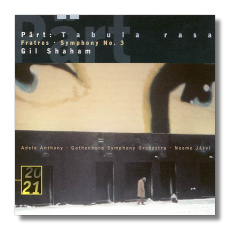
The Internet's Premier Classical Music Source
Related Links
- Pärt Reviews
- Latest Reviews
- More Reviews
-
By Composer
-
Collections
DVD & Blu-ray
Books
Concert Reviews
Articles/Interviews
Software
Audio
Search Amazon
Recommended Links
Site News
 CD Review
CD Review
Arvo Pärt

- Fratres
- Tabula Rasa
- Symphony #3
Gil Shaham & Adele Anthony, violins
Roger Carlsson, percussion
Erik Risberg, prepared piano
Göteborg Symphony Orchestra/Neeme Järvi
Deutsche Grammophon 457647-2 DDD 58:29
Pärt's Fratres exists in multiple versions. It was first performed by an early music ensemble, then there was a version for twelve cellists. This 1992 revision – really more than a simple arrangement – is scored for violin (Shaham), string orchestra, and percussion, and the timbral contrast is very effective. Furthermore, Shaham digs into the music as if it was the Sibelius Violin Concerto, and I don't expect to hear a more impassioned version of Fratres than this one. I suspect that Pärt would be surprised by Shaham's heat.
When the Estonian musicians who premièred the work saw the score to Tabula Rasa they asked the composer, "Where is the music?" Tellingly, the second of two movements is marked "Silentium: Senza moto" (Silence: without movement). It is worth remembering that Tabula Rasa is Latin for "blank slate." Also, Pärt has said that it is enough for him if a single note is played beautifully. "This single note," he said, "the sense of peace or silence have a calming effect on me." Talk like that got Pärt lumped together with other Eastern European and English composers in a critically fabricated group of "Spiritual Minimalists." Even more than Fratres, Tabula Rasa is a beautiful and austere work; it can seem overwhelmingly quiet. Again, Shaham (with Australian violinist Adele Anthony) puts the music on a high flame, shaking up its 22-year performance tradition. It works for me, and it fascinating to compare Shaham with violinist Gidon Kremer, a cooler fish altogether, who is associated with both of these works.
Pärt dedicated his Third Symphony to Neeme Järvi in 1971; Järvi recorded it with the Bamberg Symphony Orchestra in 1989. This new Swedish recording is a triumph. The conductor favors much slower tempos now, particularly in the middle movement (9:09 versus 6:22), and yet the music seems to move with a great deal more flexibility. The inclusion of the symphony on this CD is a little strange, however, because it belongs to a different stylistic world than Fratres and Tabula Rasa. Here, Pärt's inspiration is the music and the general atmosphere of the Middle Ages. It is a riot of contrasts next to the later works. There was room on this CD for Pärt's Second Symphony, a polystylistic nightmare complete with squeaky duck toys and a saccharine quotation from one of Tchaikovsky's piano works. That's really the only complaint I have about this CD, though. (The annotations also could have been a little more informative.)
This is a release in Deutsche Grammophon's 20/21 series. Like Messiaen's Saint François d'Assise, another 20/21 recording recently reviewed by me, it proves that the yellow label is not resting on its fat laurels but trying – and succeeding – to remain a viable force in contemporary classical music.
Copyright © 1999, Raymond Tuttle


















